 CONSTRUCTION KNOWLEDGE >>
GENERAL TECHNICAL KNOWLEDGE
>>
CONSTRUCTION KNOWLEDGE >>
GENERAL TECHNICAL KNOWLEDGE
>>
BASIC FLUIDS
1. What can I Learn about Water in a 55 Gallon Drum?
2. Water at Basement Walls: What Makes the Wall Fall
Down?
3. What Should I Know about Piping Systems: Pressure, Flow and Head?
4. What Should I Know about Pumps?
5. What Should I Know about Gas Pressure, Temperature and Volume?
6. What Public Domain Documents are Available for Further Study?
7. Tricks of the Trade and Rules of Thumb for Basic
Fluids:
What can I Learn about Water in a 55 Gallon Drum?
The first high concrete wall I helped form and
place taught me a great lesson about fluid dynamics. As the concrete was
being placed in this deep form on a sewage treatment plant, the bottom
of the form burst outward and concrete started flowing out into the
dirt. The experienced guys rushed around trying to re-brace the form,
then all the stories started about terrible form failures. Guys spoke
about the sound of form ties snapping and the huge danger of all that
concrete pressure. I didn't really understand where all the pressure
came from. The example of the 55 gallon drum helped me grasp the
concept.
If we fill a 55 gallon drum with water, we have a container filled with fluid. So what is unique about a fluid? Basically that it flows. A fluid flows. If we put a pumpkin in the 55 gallon drum, the pumpkin would sit on the bottom of the drum, it would exert a pressure on the bottom of the drum due to its own weight, but it would not exert any pressure on the sides of the drum.
If we filled the drum with water, though, the water would push down on the bottom of the drum but also outward against the sides. In fact, a fluid pushes perpendicularly (outward) against any surface that contains it. This pushing outward by the water against the drum surface is called pressure.
So how does this pressure vary? Fluid pressure increases with depth. So at the very top of the 55 gallon drum, no water pressure pushes outward. Go down a foot in the drum and the pressure increases. Go down to the bottom and it increases more.
Putting numbers to this concept helps make it clearer and the sketch below illustrates.
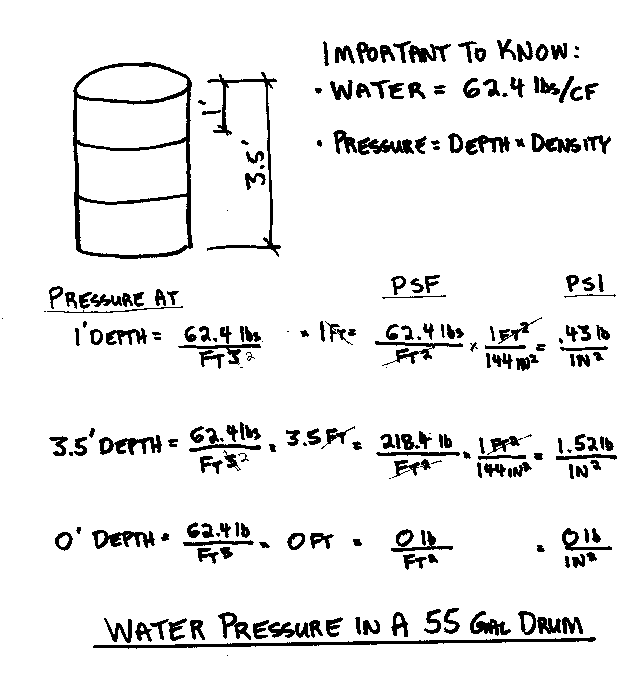
Notice the units that show the pressure on the example above. At 3.5'
depth, the water pressure pushing out (or pushing down) is 218.4 pounds
per square foot (psf). Think of a big man standing with his feet real
close together on a little 1' x1' floor tile and you've got the concept
of 218.4 psf. Now notice that 1.52 pounds per square inch (psi) is the
exact same pressure, just with a different unit. Every square inch under
that 12" x 12" floor tile would have a pressure of 1.52 psi.
It's valuable to have a working understanding of pressures in psi and psf. You probably have about 50 psi water pressure in your house. So how high a barrel of water would you need to have 50 psi pressure at the bottom? 50 psi x 144 square inches/square feet / 62.4 pounds/cubic feet yields 115 feet of water height. So you'd need a barrel of water 115 feet high to create 50 psi of water pressure.
Now think of that 50 psi of water pressure and try to think of it in
psf. How can you visualize that 50 psi of pressure in your home's water
pipes? The calculation is simple, just multiply 50 psi by 144 square
inches/square feet to get the 7200 psf answer. So if we go back to our
12" x 12" floor tile, that's our 200 pound man standing there holding 35
other 200 pound men on his shoulders. Wow!
Now let's think about another aspect of fluid pressure, does the pressure change if the 55 gallon drum changes to a 2" vertical pipe filled with water? What happens to the water pressure at 1' depth? at 3.5' depth? The water pressure stays exactly the same...it's dependent on the depth, but not on the width of the container. So the water pressure at 3.5' depth will be 1.52 psi whether it's in a 55 gallon drum, a 2" vertical pipe or against a swimming pool wall. Water pressure depends on depth. A helpful rule of thumb to remember is that every foot of height equals about 1/2 psi of water pressure. So the 3.5 foot deep 55 gallon drum has about 2 psi and the 50 psi water service about 100' of water column height. The 1/2 psi per 1' of water height is approximate, but helpful to get you in the ballpark of the actual pressures.
When thinking about concrete forming and placing of walls, though, and important consideration changes. The density of the fluid changes from 62.4 pcf for water to 150 pcf for liquid concrete. So a 18' deep concrete wall form, if it was filled completely with liquid concrete would have a pressure of 150 pcf x 18' which equals 2700 psf. Since a standard form ties typically carries about 2000 pounds, we'd need ties closer than 1' on center to pour this entire wall at one time. The normal method for wall placement involves placing the wall in lifts, so that the concrete hardens and is no longer liquid in the lower lift prior to the upper lift being placed. So if our 18' deep wall was placed in three 6' lifts, then the 150 pcf x 6' yields a wall pressure of 900 psf. Wall form ties could be placed at 2' on center (giving 2,000 pounds of structural capacity for a 1800 pound load).
Water at Basement Walls: What Makes the Wall Fall Down?
In many homes, the basement walls fail, cracking
and leaking water into the house. Did you know that water is often the
culprit for those failed basement walls? Most people don't understand
the significant pressures that water exerts on a wall. The sketch below
illustrates the concepts.
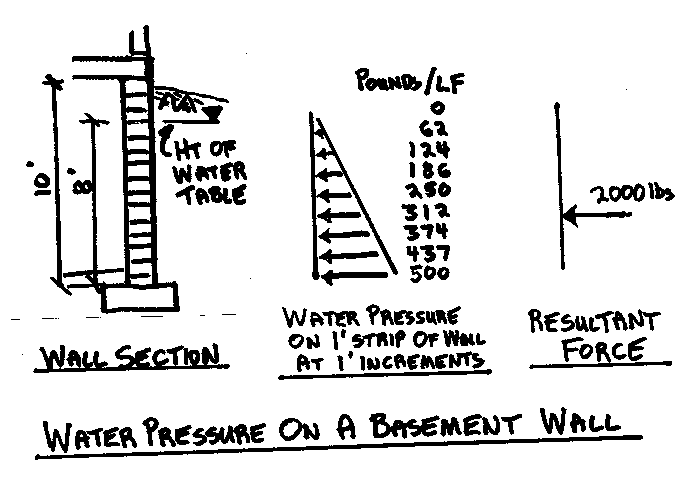
The sketch shows the water table about 8' above the bottom of the
basement wall. The pressure that water exerts on the wall gets higher
with depth. The middle sketch illustrates the concept. Many times
retaining walls and basement walls are designed assuming that any
standing water behind the wall will be released by underdrains. It's
important for the Superintendent to pay attention to underdrain details
shown on construction drawings. Many walls have failed because of water
pressure against walls that weren't designed to resist those
forces.
So when a retaining wall detail shows crushed stone and a 4" pipe at the
backfilled side of the wall, that wall was probably designed assuming
that any water behind that wall would be drained away by the
underdrain. In rough terms, that wall may have to be twice as strong to
resist those water pressure forces that come from not having proper
drainage. So make sure you pay attention to
wall underdrains if there is any possibility of water pressure behind
the wall.
![]()
What Should I Know about Piping Systems: Pressure, Flow and Head?
Bud Caldwell, one of the most amazing Superintendent's I've ever worked
with, taught me the value of understanding the basics of fluid flow. He
learned that many design Engineers knew how to do the calculations, but
didn't really understand how the pressures worked. He avoided several
disastrous results by learning both the basic equations and paying
attention to the physical realities of fluid flow. You will also benefit
from understanding the basics here.
Fluids can flow in several types of systems. In an open system, storm water may be flowing down through a swale towards the stream. In an open piping system, a water tank may have water to a height of 100' above grade, that then flows through pipes to feed home use. In a pressurized piping system, a pump adds pressure to the water flowing through those pipes. In each of these systems, the same basics of fluid pressure apply.
The thing in common, here, is the fluid flowing. The fluid starts to flow in order to equalize the pressure. That's a fancy way of saying that water flows downhill. The pressure that is equalized in fluids is called head and is the standard unit of measure for fluids. The amount of energy in the fluid stream is made up of the components in the sketch below:
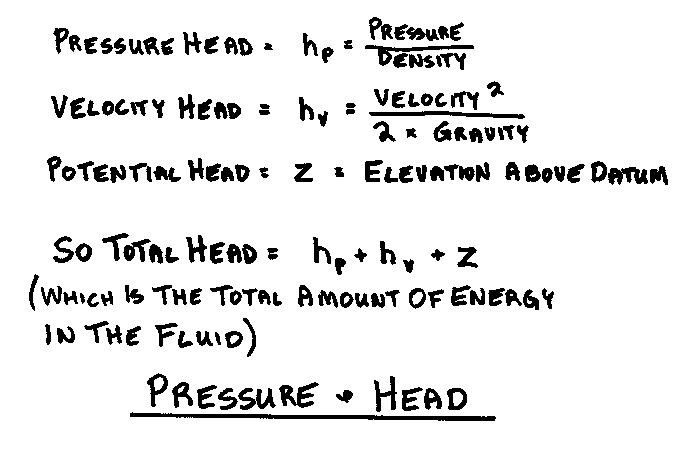
To actually use these equations in a piping system, one also must
consider the smoothness of the pipe and the friction losses that occur
as the fluid flows through the pipe. Charts that provide this
information for various types of pipe are found in the Appendix of the
International Plumbing Code.
When working with pressures, though, you need to understand the difference between absolute pressure and gage (or atmospheric) pressure. The graphic below illustrates the concept.
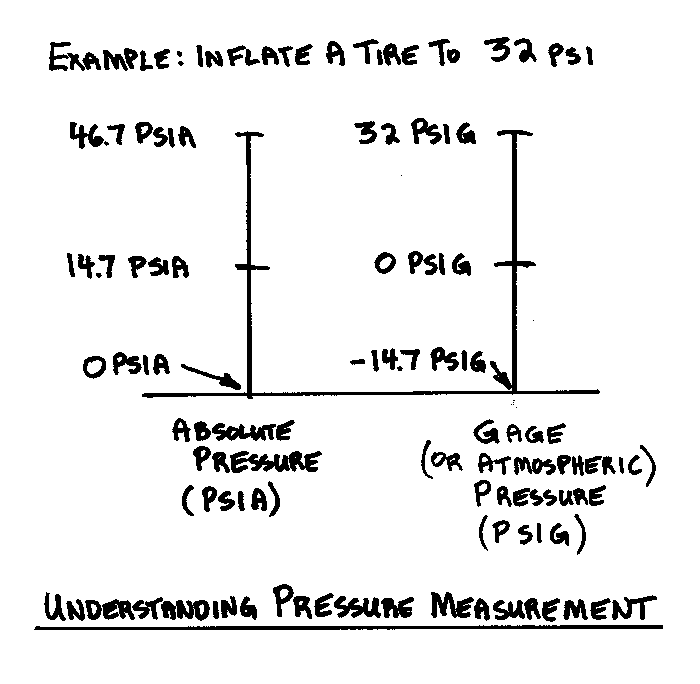
Absolute pressure is pressure in a vacuum. When dealing with real world
problems here on Earth, though, we usually work in gage (or atmospheric)
pressure. The difference between the two is obvious, but just remember
psia stands for pounds per square inch absolute pressure (in a vacuum) and psig stands
for pounds per square inch gage pressure (found on Earth).
Some useful tables, figures and worked examples for water flow in pipes
and designing water distributions are found in a
US Army Field Manual.
![]()
What Should I Know about Pumps?
On my first
large job as a project engineer, we installed a sewage sludge dewatering
press and my job was to prove that the performance of the press met the
performance specifications. So I had to figure out how much water was
going into the press and how much was coming out. I remember setting up
this test to flow the water from the pump into a large container and
measure the time to fill, figuring I could then know the gallons per
minute that was going into the press. The old Resident Engineer on the
project pulled me aside and explained that my approach was simply wrong.
He said, "Don't you understand pump curves?" I didn't and ended up
wasting lots of time and looking kind of stupid.
As the old fellow (who was probably about the age I am now) explained to me, a pump curve shows how a pump actually delivers under various levels of flow restriction. In other words, the amount of fluid pumped will vary greatly with the amount of friction head or elevation head it must overcome. That made sense to me after I thought about it. Pump curves can be obtained from the pump manufacturers when you have a specific pump to evaluate. So as a simple trick of the trade, remember to use pump curves if you need to evaluate how a pump will perform.
A pump moves and/or compresses fluids, creating velocity and pressure. The basic three types of pumps are centrifugal, reciprocating and rotary.
Centrifugal pumps use centrifugal force to force the liquid out away from the central rotating shaft. The impeller blades used to move this fluid are curved backward relative to the direction of flow (see sketch below). As the fluid spins outward, it exits through the discharge with increased speed and pressure. The intake of fluid is often near the center of the propellers. Multi-stage centrifugal pumps have the discharge from one pump directly tying into the intake of the next pump, thus increasing both velocity and pressure of the fluid.
Reciprocating pumps use a back and forth motion to displace the liquid with solid pump piston or plunger. This positive displacement of the liquid creates a compression and increased pressure. Since the piston or plunger needs to be tight fitting to create that compression, packing or piston rings need to be used, as well as check valves. In construction, reciprocating mud pumps or trash pumps tend to be the workhorses on a job site. They can pump out areas filled with water and tend to not clog too easily.
Rotary pumps are also positive displacement pumps, though their flow is continuous in one direction and no check valves are required. The sketch below illustrates the concept.
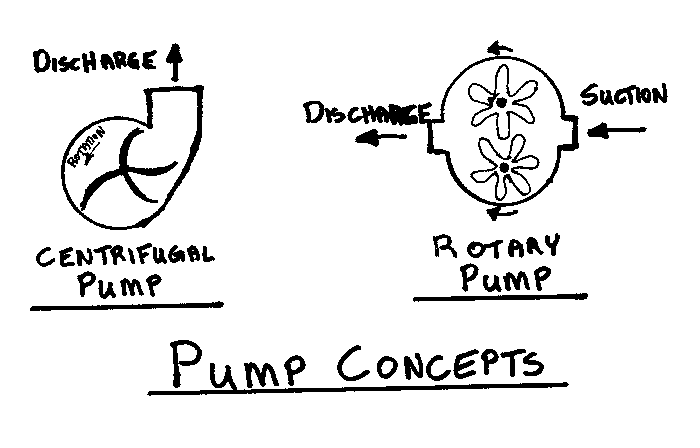
What Should I Know about Gas Pressure, Temperature and Volume?
It's
helpful to know a couple of basics about how gases behave. A gas flows,
as does a liquid. Unlike a liquid, though, gas fills a container and
exerts a constant pressure on all sides of that container. Two simple
rules about gases come in handy:
- The pressure of a gas varies directly with the temperature when the volume is constant. For example, if a bottle of oxygen gas is in a fire, as the temperature rises, the pressure will rise proportionally. Of course, that bottle of oxygen in a fire creates a very dangerous possibility of exploding (that's why it's good to understand this concept).
- The volume of a gas varies directly with the temperature when
the pressure is constant. Think about a balloon that's heated, the
pressure is constant but the volume will expand proportionately with
the temperature.
What Public Domain Documents are Available for Further Study?
- Additional information regarding fluid power can be obtained from the US Navy's Training Course (NAVEDTRA 14105, July 1990).
- A complete guide to Thermodynamics, Heat Transfer, and Fluid Flow is provided in a 3-part manual. Volume I is titled DOE-HDBK-1012/1-92 (June 1992) and is 138 pages, Volume II is 32 pages and titled DOE-HDBK-1012/2-92 (June 1992), and Volume III titled HT-03 is 12 pages.
Tricks of the Trade & Rules of Thumb for Basic Fluids:
- Water pressure depends on depth. Every foot of height equals approximately 1/2 psi.
- Psia stands for pounds per square inch absolute pressure (in a vacuum) and psig stands for pounds per square inch gage pressure (found on Earth).
- Use manufacturer's pump curves if you need to evaluate how a pump will perform.
- The pressure of a gas varies directly with the temperature when the volume is constant.
- The volume of a gas varies directly with the temperature when the pressure is constant.

